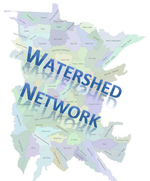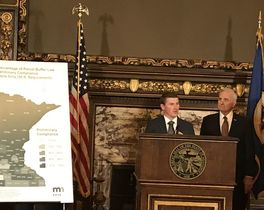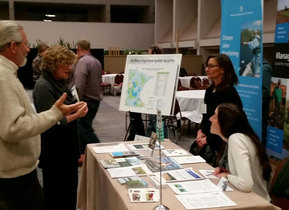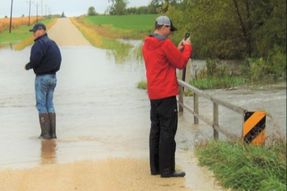November 2017
The Clean Water Partnership (CWP) program is now offering loans at a zero percent interest to applicants who have applied after July 1, 2017. Loans can be up to $2 million. CWP loans offer great flexibility; any government entity with taxing authority can apply.
Other groups (SWCDs, WMOs, etc.) can administer the loans. Funds can be loaned again as a second-tier loan to farmers, businesses, and homeowners at a maximum interest rate of 1.5 percent. They also can match for federal and state grants.
Funds can be used for SSTS upgrades or repair, green infrastructure, upgrades to feedlots, equipment, and best management practices. A fact sheet with more information is available on the MPCA's Clean Water Partnership webpage. There is no annual call for applications; they can be submitted at any time.
 The Watershed Professionals Network fall program is scheduled for 9:30 a.m.-noon Tuesday, Nov. 28 at the (newly-reopened) New Ulm Pizza Ranch, 1927 S. Broadway. This is a great opportunity for watershed organization and agency staff to network and learn about interesting topics. The program line-up includes:
Launched in 2009, the network provides a monthly e-newsletter and hosts meetings in the spring and fall. For more information contact Forrest Peterson, forrest.peterson@state.mn.us, 320-979-1776.
Back to top
|
The MPCA will be awarding nearly $2.8 million in grants to
10 projects under the federal Clean Water Act Section 319 program. The U.S. EPA
awarded the funds in the 2017 federal fiscal year to address nonpoint source
pollution. Project sponsors must match the grants by at least 40% of total
costs, bringing the total investment to nearly $4.8 million.
Addressing runoff from both agricultural and stormwater
sources, the projects plan to reduce nutrient, bacterial, and sediment runoff
from nonpoint sources. Selected from a pool of 21 eligible applicants, the
projects are:
- Carnelian Marine Stormwater Phase 2, Carnelian-Marine-St.
Croix Watershed District, $92,588
- Goose Lake Total Maximum Daily Load Final
Implementation, Carnelian-Marine-St. Croix Watershed District, $76,000
- Hawk Creek Watershed Improvement Project, Hawk
Creek Watershed Project, $397,000
- Lake Osakis Minor Watershed Nutrient Reduction,
Todd County Soil and Water Conservation District, $300,000
- Lower Sand Creek Corridor Restoration, Coon
Creek Watershed District, $269,563
- Lower St. Croix Targeted Phosphorus Reduction, Washington
Conservation District, $300,000
- Mankato Watershed-Renville County Improvement,
Hawk Creek Watershed Project, $297,000
- National Water Quality Initiative Seven Mile
Creek, Gustavus Adolphus College, $475,524
- Reducing Bacteria Runoff from Southeast Minnesota
Feedlots, Southeastern Minnesota Water Resources Board, $336,000
- Whitewater Watershed Nitrogen Reduction, Whitewater
Joint Powers Board, $232,825
Back to top
 At a news conference last week, Gov. Dayton thanked Minnesota farmers for taking advantage of the bipartisan buffer law’s flexibility and additional funding to participate fully in the statewide effort to improve water quality and wildlife habitat. Minnesota is now at least 95 percent compliant with the statewide water quality effort. Photo: Justin Hanson, district manager for Mower Soil and Water Conservation District and administrator for the Cedar River Watershed District, speaking at the event.
The Board of Water and Soil Resources and Dept. of Agriculture worked with farmers and local experts to develop alternative practices that have equivalent water quality benefits to buffers. These helped farmers make choices to protect water quality in ways that work best for them. This leadership by farmers was critical to the state meeting at least 95 percent buffer compliance by Nov. 1.
Progress toward buffer compliance is strong ahead of first implementation deadline
Back to top
|
 Various programs of the MPCA will be represented at the trade show of the Minnesota Association of Soil and Water Conservation Districts convention Dec. 3-5. The main trade show occurs on Monday, Dec. 4. Tuesday, Dec. 5, the "Conservation Information Fair" from 7:30 a.m. to noon.
Businesses and agencies participating in the fair "will have the opportunity to meet with the award-winning landowners, farmers, sportsmen, and conservation leaders from around the state." The MPCA will be participating in both events. Photo: MPCA table at the 2016 Conservation Fair.
In the past, MPCA programs represented in the Monday trade show included feedots, construction stormwater, citizen monitoring, subsurface sewage treatment systems, nutrient reduction strategy, and Watershed Restoration and Protection Strategy. The convention program includes business meeting, awards, and a variety of concurrent education sessions. The Minnesota Association of Soil and Water Conservation Districts represents the 89 soil and water conservation districts of Minnesota.
Back to top
|
 The 9th Minnesota River Congress will be Thursday, Nov. 16 at the SCALE Regional Training Facility, 17706 Valley View Drive, Jordan. The Networking Fair begins at 4:30 p.m., followed by dinner at 6 and program at 7. In addition to exhibits from a variety of organizations, the networking fair will feature a series of five-minute presentations by exhibitors.
The dinner menu is fried chicken, coleslaw, potato salad, coffee, water and soda. Featured program speaker Patrick Belmont will talk about "Past, Present and Potential Futures for the Minnesota River." The Congress will review progress on resolutions, interest network teams and board activities. Cost: $20 per person. Young adults under 19 or with a college ID for free. Make checks payable to CCMR (Coalition for a Minnesota River) PO Box 488, New Ulm, MN 56073. Register online. To register for the Networking Fair contacting the coordinator Scott Sparlin directly at sesparlin@gmail.com, 507-276-2280.
Representatives needed for Action Board
If you or someone you know are interested in participating on the Congress Action Board, and can participate in at least three meetings during 2018, you are encouraged to apply now if you fall into one of the open categories listed below. It is a two-year commitment and applications are being accepted up to the Nov 16 next full congress session. Open seats include: Agriculture, Local Government (includes SWCD supervisors), Business, Recreation, Watonwan River Watershed, Minnesota River Headwaters, Pomme de Terre Watershed, Hawk Creek Watershed, Native American Communities (2). To receive the one-page application form contact Scott Sparlin.
Back to top
|
DNR River
Ecology Unit spring workshop March 19-21
The
Science of Healthy Waters: The Ditching Dilemma workshop will be March
19-21, in Blue Earth. It will review the history, extent of ditching across the landscape, ditch
law/policy, effects of ditches on stream hydrology,
geomorphology, water quality, aquatic habitat, and biodiversity. Alternative design concepts and approaches that work towards
accomplishing sustainable agricultural goals while improving water quality and
restoring channel stability and ecological health will be presented. Group
activities will give attendees the chance to discuss the societal and
ecological implications of these practices while working towards alternative approaches
and strategies that reduce the impacts of ditching on stream health. Cost is
$300.
U of M watershed specialist
training Jan. 16-April 29
The Minnesota Watershed
Specialist Training is designed to help staff from SWCDs, watershed districts, tribes,
counties, and cities strengthen their ability to protect water resources. It is
entirely online to save travel costs and interact with professionals from
around the state. Topics include:
- assessing
the community and stakeholders to more effectively engage them in
problem-solving,
- identifying
social and physical data needs so you can design a monitoring or
evaluation program,
- writing
a communication strategy and effectively getting your message across to
diverse audiences,
- justifying
implementation activities that will best address the local water resource
issues, and
- pulling
it all together into a work plan that could be used for a grant proposal.
For more information contact Ann Lewandowski or Karen
Terry,
University of Minnesota Water Resources Center,
St. Paul, 612-624-6765.
Back to top

With the removal of a small dam, a small, endangered fish can
now migrate up Pipestone Creek into Indian Lake and beyond. The DNR worked with
local partners who removed the dam in 2016 at the outlet on Indian Lake north
of the Pipestone National Monument within the Pipestone Wildlife
Management Area. The Topeka Shiner is a federally endangered, small fish
species found in Minnesota only in the Big Sioux and Rock River watersheds.
In poor condition, the sheet piling dam was replaced with
2,100 tons of local red rock in seven riffles allowing fish passage while
maintaining the shallow lake. The riparian corridor was seeded with native
vegetation after construction. The project improves connectivity for
aquatic organisms and provides a stable and more natural outlet for Indian
Lake.
DNR Clean Water staff and River Ecology Unit staff, as well as
the area hydrologist reviewed and suggested changes to the plans developed by
the Southwest Prairie, Technical Service Area Engineer Russell
Hoogendoorn. Funding for the project came from the US Fish and Wildlife
Service (USFWS) Cooperative Recovery Initiative Grant. The Pipestone SWCD
provided construction inspection and locally administered the grant on behalf
of the USFWS.
DNR Clean Water staff and River Ecology Unit
staff, as well as the area hydrologist reviewed and suggested changes to the
plans developed by the Southwest Prairie, Technical Service Area Engineer
Russell Hoogendoorn. Funding for the
project came from the US Fish and Wildlife Service (USFWS) Cooperative Recovery
Initiative Grant. The Pipestone SWCD provided construction inspection and locally administered
the grant on behalf of the USFWS.
Back to top
|
 Known for flash flooding,
the Dobbins Creek subwatershed could see significant water-quality progress
with more cover crops and less tillage on its farm fields, according to a new
study reported in a Cedar River Watershed District news release. Photo: CRWD staff at flooded bridge last year in Red Rock Township.
Stormwater flow
likely would be reduced by 30 percent in the Dobbins subwatershed that enters
the Cedar River in Austin with best-management practices implemented in
critical areas along with 30 percent of its farmland getting year-round
vegetative cover, including crops, cover crops and post-harvesting residue, the
study says.
Jim Solstad, a retired state modeling
hydrologist, presented CRWD staff with the
results of his study that included work on the Dobbins subwatershed. With the findings, local staff now can see a
realistic scenario in which agricultural economics and water-resource
improvements can go together, CRWD administrator Justin Hanson said.
Modeling in the study, funded by a state Clean Water Legacy grant, analyzed land-management
practices particularly for how much each practice could offer for stormwater
flow reduction. Much of the sediment runoff in Dobbins is caused by high flows.
Back to top
|
 Nicole Erickson new technician for CROW
Nicole Erickson is the new watershed resource technician for the Crow River Organization of Water. Nicole joined the CROW in October with a background in water quality field work, outreach, and program development for watersheds in Minnesota. From northern Minnesota, she completed her degree in water resources at the University of Wisconsin-Stevens Point. Previously, Nicole was a water monitoring technician for the Pomme de Terre River Association.
|
LqP-Yellow Bank invites entries for 2018 calendar photo contest
The Lac qui Parle-Yellow Bank Watershed District inivites entries for its annual 2018 calendar photo contest. Cash prizes of $50, $30, and $20 will go to the top
three. It is not necessary to live in the watershed, but photos need to come from within the watershed. Please
limit entries to three photos and submit by Nov. 15. Entry form on the lqpybwatershed.org website in the Permits &
Applications tab. Submit photos and application form to mitch.enderson@lqpco.com. For more information contact Mitch at 320-598-3319. In addition to the calendar, submitted photos may be used by the watershed for our website, Facebook, and other promotional materials.
Gulf hypoxia task force sends 2017 report to Congress
The Gulf of Mexico Hypoxia Task Force is
releasing its 2017
Report to Congress on the actions the federal, state, and tribal members
have taken toward the goal of reducing
nitrogen and phosphorus pollution in the Mississippi/Atchafalaya River Basin
and shrinking the size of the Gulf of Mexico hypoxic zone. The report:
- Discusses the environmental, economic, and social impacts of
Gulf of Mexico hypoxia and harmful algal blooms;
- Provides information about the size of the hypoxic zone
since 1985 and sources of nutrient loading in the MARB;
- Describes the progress of state nutrient reduction strategy
development and implementation;
- Discusses federal agency programs that support state
implementation of nutrient reduction strategies;
- Evaluates and highlights lessons learned by presenting broader
HTF successes and successful state projects; and
-
Focuses on recent HTF efforts to track the environmental
results of state strategy implementation.
Hawk Creek Watershed Project to meet Nov. 27
The next Hawk Creek Watershed Project public meeting will
be 10 a.m. Nov. 27 at the Maynard Event Center, 341 Cynthia St., Maynard. Agenda items include: Willmar chain of lakes-impaired waters list update, Hawk Creek WRAPS and TMDL update, One Watershed One Plan-Julie Westerlund, BWSR.
Cover crop field day Nov. 17 near Brandon
The Land Stewardship Project is hosting a cover crop field day at the John
Ledermann farm near Brandon 2-4 p.m. Friday.
See cover crops being successfully integrated into corn, bean and
wheat production. Ledermann will be discussing why he plants cover crops, the
impacts he’s seen on his soil, the economics of planting covers, timing and
planting methods. This event is free and open to the public. The address is 7325 County Road 109 NW, Brandon, MN 56315. For details, contact Bryan Simon at 320-492-2526 or bsimon@landstewardshipproject.org
Back to top
|